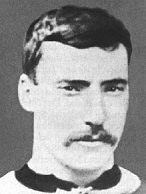James (Jimmy) Cowan

James "Jimmy" Cowan was the man, who at Scottish, attacking centre-half followed, albeit after a brief, "admin" delay, the pioneer, James Kelly, in the national team, having quite probably learned the role by observation at local club level. He is also said to have been, if anything, better still than Kelly.
Cowan's birthplace is sometimes given as Jamestown but it was actually Bonhill. The year was 1868, so he was three years the original maestro's junior. His father was Charles, English-born and an Engraver, his locally-born, mother Janet MacCaulay or Mcaulay. They had married only earlier that year, she said to be twenty-three years his junior and were to have six children, James, John, Charles Jnr born in 1874 etc.
But that is where something of a mystery begins. In 1871 his father and mother, she under her maiden name, are staying on Cunningham's Land in Bonhill with her parents, her father incidentally Islay-born. They have two of their children with them, John, aged one so born 1869/70, also a future professional footballer with Aston Villa, but no James but a Francis, aged 3, so born probably in 1867. James only seems to appear a decade later and again living with his grandfather, but without John. However, closer inspection of the record indicates a possible misreading of the given Christian name Frances plus a marginal mistake in age.
However, at that point Charles and Janet seem to disappear from the record completely; not even deaths are registered. Moreover, James only appears a decade later, again living with his grandfather, his grandmother having died. There is no John, no Charles Jnr. But again there are explanations. The family is now actually in Jamestown with his father's age proving to be another possible mis-recording. Now he is three years older than his wife, not twenty-three. And James is probably just stopping the night with Grandpa.
Indeed, in 1891 the family is still together and living on Napierston Terrace, between Bonhill and Jamestown. But James by then was already on his way. One source has him possibly playing his junior football at Renton. More likely it was at nearby Vale Athletic, which at eighteen led him into to the senior game at Vale of Leven. However, he there was to stay just two seasons before in 1889 moving south to Warwick County FC, the football section of the county cricket team, which was recruiting, including from Scotland, as it joined the Midlands County League. And it was presumably at Edgbaston that fellow-Scot and Secretary of Aston Villa, George Ramsay, saw and signed him.
James Cowan was to stay with Aston Villa for fully twelve seasons, a one English-club man. There he would play and captain teams that would two FA Cups and five league titles, including the 1891 Double, where he played alongside his brother, John. He would also from 1896, once English-based Scots were permitted in the team, to win three caps all against England and in succession, captaining the national side in 1898. However, in the game he played badly as Scotland was gubbed, was accused of being drunk on-field and, whilst he continued to lead the Villa to success, was never capped again with the mantle then passed to Alex Raisbeck. And whilst all this was coming to pass Cowan would return to Scotland in 1896 to win the Powderhall Sprint in Edinburgh and that same year marry in Birmingham with siblings, Jessie and John, as witnesses and recorded both as a Professional Footballer and an Athlete. His bride was Amy Rutherford Law, herself the granddaughter of a Scot. They were to have just one child, a son, also James, born in 1897.
Jimmy Cowan Snr would retire from playing in 1902 aged thirty-one but continue to coach at Villa Park before in 1906 being recruited to London as manager of the then Southern League Queen's Park Rangers. He would within two seasons take the Southern League title, the year mid-table Tottenham Hotspur was elected to the Football League, rebuild the team and take it once more in 1912. However, in the Autumn of 1913 with the club in mid-table he resigned citing ill-health. And within five years at the age of just fifty and still in London he died in December 1918 in St. Bartholomew's Hospital. His wife would survive him by sixteen years, dying in Hackney, London in 1934. In fact both his mother and father would also outlive him still in Bonhill, he dying in 1923, aged seventy-seven, and she in 1929 at eighty-one.
Birth Locator:
1868 - Burn St. Bonhill, Dunbartonshire
Residence Locations:
1871 - Cunningham's Land, Bonhill, Dunbartonshire
1881 - 39, Hill Bank, Bonhill, Dunbartonshire
1891 - Birmingham
1897 - 93, Carlton Road, Saltley, Warwickshire
1901 - N/A
1911 - 42, Acton Lane, Willesden, London
1918 - 255, Wick Road, Homerton, London
Death Locator:
1918 - St. Bartholomew's Hospital, London
Burial Locator:
N/A
Back to Alexandria and Bonhill,
or
or the SFHG Home page